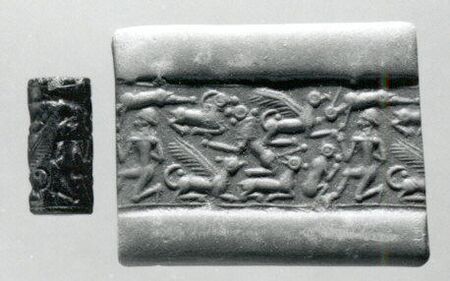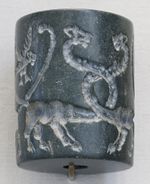ميتاني
مملكة ميتاني | |||||||||||
|---|---|---|---|---|---|---|---|---|---|---|---|
| ح. 1600 ق.م.– ح. 1260 ق.م. | |||||||||||
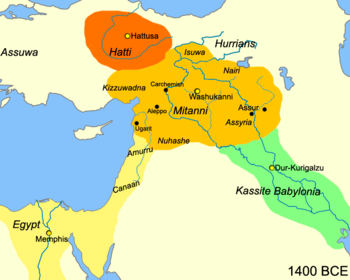 مملكة ميتاني في أقصى اتساعها، بعهد Parshatatar ح. القرن 15 ق.م. | |||||||||||
| العاصمة | واشوكاني | ||||||||||
| اللغات المشتركة | اللغة الحورية | ||||||||||
| الدين | |||||||||||
| الحكومة | ملكية | ||||||||||
| ملك | |||||||||||
• ح. 1540 ق.م. | كيرتا (أول ملك معروف) | ||||||||||
• ح. 1300 ق.م. | شطوارا الثاني (الأخير) | ||||||||||
| الحقبة التاريخية | العصر البرونزي | ||||||||||
• تأسست | ح. 1600 ق.م. | ||||||||||
• انحلت | ح. 1260 ق.م. | ||||||||||
| |||||||||||
| جزء من سلسلة عن |
| المواضيع الهندو-أوروپية |
|---|
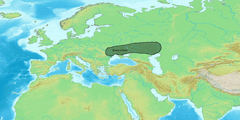 |
ميتانـّي (Mitanni ؛ /mɪˈtæni/ ؛ مسمارية حيثية 𒆳𒌷𒈪𒋫𒀭𒉌 KUR URUMi-ta-an-ni؛ Mittani 𒈪𒀉𒋫𒉌 Mi-it-ta-ni)، كما كانت تُدعى هانيگـلبات أو هاني-ربـّات (Hanikalbat أو هانيگـلبات مسمارية هانيگـلبات 𒄩𒉌𒃲𒁁 Ḫa-ni-gal-bat, Ḫa-ni-rab-bat) في النصوص الآشورية أو نهارين في النصوص المصرية، كانت أهم مملكة حورية تابعة للحيثيين في شمال سوريا، حوالي سنة 1500 ق.م. في شمال الهلال الخصيب عند منابع الخابور.
Currently there are two hypotheses regarding how Mitanni was formed: that Mitanni was already a powerful kingdom at the end of the 17th century or in the first half of the 16th century BC, and its beginnings are from before the time of Thutmose I, so dated to the time of the Hittite sovereigns Hattusili I and Mursili I,[1] when the middle chronology is applied;[2] or that Mitanni came to be due to a political vacuum in Syria, which had been created first through the destruction of the kingdom of Yamhad by the Hittites and then through the inability of Hatti to maintain control of the region during the period following the death of Mursili I.[1]
If the second hypothesis is considered, Mitanni (c. 1500 to 1300 BC as per short chronology) could have come to be a regional power after the Hittite destruction of Amorite[3] Babylon occurred in 1531 (also in short chronology), and a series of ineffectual Assyrian kings created a power vacuum in Mesopotamia.
While the Mitanni kings and other members of royalty bore names of Indo-Aryan origin,[4] and invoked Indo-Aryan deities attested in the Rigveda, they probably used the language of the local people, which was at that time a non-Indo-European language, Hurrian. Their sphere of influence is shown in Hurrian place names, personal names and the spread through Syria and the Levant of a distinct pottery type.
. . . . . . . . . . . . . . . . . . . . . . . . . . . . . . . . . . . . . . . . . . . . . . . . . . . . . . . . . . . . . . . . . . . . . . . . . . . . . . . . . . . . . . . . . . . . . . . . . . . . . . . . . . . . . . . . . . . . . . . . . . . . . . . . . . . . . . . . . . . . . . . . . . . . . . . . . . . . . . . . . . . . . . . .
الامتداد
بلغت رقعة المملكة الميتانية في أوج توسعها من نوزي شرقاً، (قيليقيا) كلها، وصولاً إلى حلب غرباً،ومازالت اثار اميتانيين ماثلة في اللاذقية و حمص ، وكانت مركز المملكة عند منابع الخابور، حيث كانت إحدى عواصم المملكة (واشوكانو/واشوكاني) التي تدل على انها تل الفخيرية في سوريا ويلاحظ ان امتداد هذه الرقعة في منطقة الجزيرة السورية وجنوب شرق تركيا و شمال شرق سوريا محيطة بالعاصمة واشوكاني.
الاقتصاد
مكنت طبيعة الأراضي الخصبة والهطولات المطرية العالية، سكان المنطقة من إنتاج زراعي جيد وكذلك نربية للأبقار الخراف والماعز، كذلك مارس السكان التجارة، وبالنظر إلى أن المعلموات المباشرة عن المملكة قليلة، فإن الاعتماد على المصادر المحيطة، كأرشيف نوزي من مملكة عرفة والنصوص من ألالاخ تمكن من تحديد السوية الإقتصادية الجيدة للمملكة الميتانية.
اللغة والسكان
الشواهد اللغوية المعروفة في المملكة الميتانية هي بشكل أساسي الحورية والأكادية والأناضولية القديمة، كذالك بعض الكلمات والاسماء الهندوآرية مثل بعض أسماء الاشخاص والواحق الاسمية وأسماء بعض الآله،وكانت المملكة الميتانية كبقية ممالك الشرق القديم عبارة عن خليط من مجموعات لغوية متعددة، وإن يكن بشكل أساسي من الحوريين والأموريين والآشوريين وأراميون ومجموعات هندوآرية
التاريخ
No native sources for the history of Mitanni have been found so far. The account is mainly based on Assyrian, Hittite, and Egyptian sources, as well as inscriptions from nearby places in Syria. Often it is not even possible to establish synchronicity between the rulers of different countries and cities, let alone give uncontested absolute dates. The definition and history of Mitanni is further beset by a lack of differentiation between linguistic, ethnic and political groups.
Summary
It is believed that the warring Hurrian tribes and city states became united under one dynasty after the collapse of Babylon due to its sacking by Hittite king Mursili I, and the Kassite invasion. The Hittite conquest of Aleppo (Yamhad), the weak middle Assyrian kings who succeeded Puzur-Ashur III, and the internal strife of the Hittites had created a power vacuum in upper Mesopotamia. This led to the formation of the kingdom of Mitanni.
The first known use (by now) of Indo-Aryan names for Mitanni rulers begins with Shuttarna I who succeeded his father Kirta on the throne.[5] King Barattarna of Mitanni expanded the kingdom west to Aleppo and made the Amorite[6] king Idrimi of Alalakh his vassal,[7] and five generations seems to separate this king (also known as Parattarna) from the rise of Mitanni kingdom.[8] The state of Kizzuwatna in the west also shifted its allegiance to Mitanni, and Assyria in the east had become largely a Mitannian vassal state by the mid-15th century BC. The nation grew stronger during the reign of Shaushtatar, but the Hurrians were keen to keep the Hittites inside the Anatolian highland. Kizzuwatna in the west and Ishuwa in the north were important allies against the hostile Hittites.
After a few successful clashes with the Egyptians over the control of Syria, Mitanni sought peace with them, and an alliance was formed. During the reign of Shuttarna II, in the early 14th century BC, the relationship was very amicable, and he sent his daughter Gilu-Hepa to Egypt for a marriage with Pharaoh Amenhotep III. Mitanni was now at its peak of power.
However, by the reign of Eriba-Adad I (1390–1366 BC) Mitanni influence over Assyria was on the wane. Eriba-Adad I became involved in a dynastic battle between Tushratta and his brother Artatama II and after this his son Shuttarna II, who called himself king of the Hurri while seeking support from the Assyrians. A pro-Hurri/Assyria faction appeared at the royal Mitanni court. Eriba-Adad I had thus loosened Mitanni influence over Assyria, and in turn had now made Assyria an influence over Mitanni affairs.[9] King Ashur-Uballit I (1365–1330 BC) of Assyria attacked Shuttarna and annexed Mitanni territory in the middle of the 14th century BC, making Assyria once more a great power.[10]
At the death of Shuttarna, Mitanni was ravaged by a war of succession. Eventually Tushratta, a son of Shuttarna, ascended the throne, but the kingdom had been weakened considerably and both the Hittite and Assyrian threats increased. At the same time, the diplomatic relationship with Egypt went cold, the Egyptians fearing the growing power of the Hittites and Assyrians. The Hittite king Suppiluliuma I invaded the Mitanni vassal states in northern Syria and replaced them with loyal subjects.
In the capital Washukanni, a new power struggle broke out. The Hittites and the Assyrians supported different pretenders to the throne. Finally a Hittite army conquered the capital Washukanni and installed Shattiwaza, the son of Tushratta, as their vassal king of Mitanni in the late 14th century BC. The kingdom had by now been reduced to the Khabur Valley. The Assyrians had not given up their claim on Mitanni, and in the 13th century BC, Shalmaneser I annexed the kingdom.
The following is a tentative correlation of Mitanni with nearby kingdoms until the reign of Tusratta by Stefano de Martino:[11]
| Mitanni | Egypt | Hatti | Alalah | Kizzuwatna | Terqa |
|---|---|---|---|---|---|
| Principate of Mittani | Hattušili I | ||||
| Rise of the kingdom of Mittani | Muršili I | ||||
| First attestation of Mittani | Tuthmosis I | ||||
| Kirta (?) | |||||
| Šuttarna I (?) | ? Qiš-Addu | ||||
| Parattarna I | ? Tuthmosis III ? | Zidanza II | Idrimi | Pilliya | Qiš-Addu |
| Sausadat (??) | |||||
| Parsatatar | |||||
| Sauštatar | ? Tuthmosis III ? | Tuthaliya I/II | Niqmepa | Šunaššura | ? Qiš-Addu |
| Parattarna II (??) | |||||
| Artatama I | Tuthmosis IV | ||||
| Šuttarna II | Amenophis III | ||||
| Artašumara (Uthi) | |||||
| Tušratta | Amenophis IV | Šuppiluliuma I |
المملكة المبكرة
منذ نهاية الألفية الثالثة ق.م. تشكلت في مناطق الجزيرة الفراتية ومحيطها إمارات صغيرة، أخذت بالنمو تدرجياً، يذكر منها أوركيش، والتي ضمت إليها مواقع ومستوطنات أصغر، كانت قد نشأت في مناطق تواجد حوريي اللغة من زاغروس إلى منابع الخابور، إلا أن انتشار حوريي اللغة يمكن تتبعه حتى حوض العاصي وفي شرق الهلال الخصيب حتى ماري وبابل حيث شكلوا نسبة من العمال والعبيد، أما في يمحاض (حلب) فقد أصبحوا من علية القوم، ومن النقش على تمثال إدريمي ملك ألالاخ (1470 ق.م) نقرأ لأول مرة عن مملكة حورية-ميتانية، التي يفترض بها قد نشأت في نهاية القرن السادس عشر ق.م. وامتدت حتى شواطئ البحر الأبيض المتوسط في سورية.
بدايات المملكة الميتانية لازالت غامضة، وليس معروفاً كيف أزداد دور اللغة الهندوآرية فيها،أكان ذلك عن طريق دخول مجموعات هندوآرية اللغة، أم أن الحوريون نفسهم تبنوا هذه اللغة، مع أن قلّة من الملوك كانوا يحملون أسماء حورية.
. . . . . . . . . . . . . . . . . . . . . . . . . . . . . . . . . . . . . . . . . . . . . . . . . . . . . . . . . . . . . . . . . . . . . . . . . . . . . . . . . . . . . . . . . . . . . . . . . . . . . . . . . . . . . . . . . . . . . . . . . . . . . . . . . . . . . . . . . . . . . . . . . . . . . . . . . . . . . . . . . . . . . . . .
فترة القوة
يمكن الاسنتاج من أن حملة تحتمس الأول (1492- 1504 ق.م.) على سوريا، على أنها بداية المواجهة بين مصر الفرعونية والمملكة الميتانية، حتى أنه نصب تذكاراً له غرب الفرات في الجزيرة السورية، وما تابعه تحتمس الثالث (1479- 1425 ق.م) من حملات.
أرتاشومارا و توشراتا
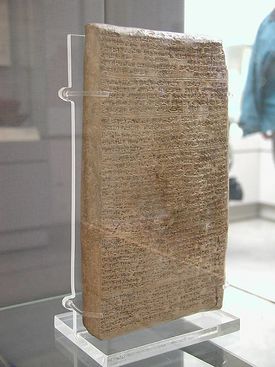
إلا أنه ليس واضحاً الدور الذي لعبته ميتاني في التحالف السوري الذي قاده مللك قادش في معركة مجدو(1456 ق.م) ضد الملك المصري تحتمس الثالث، لكن الواضح أن المواجهات المصرية الميتانية السورية القديمة كانت في العام (1446 ق.م) حيث تقابل الجيشان إلى الغرب من حلب . لم يكن سهلاً على الجيش المصري التحكم في كامل غرب وشمال الهلال الخصيب وإن كان قد وضع حاميات عسكرية في بعض المدن كما في جبيل، إلا أن ذلك لم يحد من ثورة بعض مدن الساحل الكنعاني، وكذلك شهدت هذه الفترة زيادة نفوذ ميتاني في كامل شمال الهلال الخصيب، حتى أن أوغاريت كانت إحدى الدويلات التابعة لميتاني في بعض الفترات، كما أن بعض الدويلات التابعة سابقاَ للممكة الحيثية أنضمت إلى ميتاني مع نهاية القرت الخامس عشر ق.ميتاني كانت قد أخضعت آشور وعقد تحالفات مع الدولة البابلية.
لاحقاً بدأت العلاقات الميتانية المصرية بالتحسن، ويشهد على ذلك الزيجات المتبادلة بين الملوك والرسائل المتبادلة بين طيبة و واشوكانو/ واشوكاني (سوريا) في رسائل تل العمارنة، كما في رسالة من المللك الحوري شوتارنا الثاني (Shuttarna II) مللك ميتاني إلى الملك المصري أمنحوتب الثالث (Amenophis III).
ثم تلى ذلك صراعات على العرش بين أمراء المملكة أدى إلى فترة ضعف. لاحقاً قام الملك الآشوري آشور أوبليط الأول( 1363- 1328 ق.م) باستعادة الدور الآشوري في المنطقة مسبباً تشظي المملكة الميتانية في وحدات صغيرة.
ميتاني بين آشور وحاثي
عقد الأمير شاتيوازا (Shattiwaza)، حكم أقليم هانيلجابات 1335- 1320 ق.م معاهدة تبعية مع ملك الحيثيين شوبيلوليوما الأول (Suppiluliuma I) وأصبحت المنطقة متنازع عليها من القوتين الآشورية والحيثية، وتزايدة الهجمات الآشورية علة المنطقة في عهد آداد نيراري الأول (1305- 1275 ق.م) حتى أنه بنى قصراُ له في إحدى عواصم المنطقة، كما رحل مجموعات من السكان نحو مدينة آشور.
أما من الجانب الحيثي فقد شاركت القوات الميتانية مع ضمن القوات الحيثية في معركة قادش (1285 ق.م) وسط سوريا ضد القوات المصرية، وعادت المناوشات والسيطرة الآشورية على المنطقة، حتى زمن الملك الآشوري توكولتي نينورتا الأول (1243- 1207 ق.م.) والذي بسط نفوذ المملكة الآشورية من بابل وحتى نياري (ڤان حالياً)، إلا أن المنطقة بقيت منطقة نزاع بين الآشوريين والحيثيين، حتى نهاية الألف الثاني ق.م و ظهور الممالك الآرامية كقوة جديدة سيطرت على المنطقة .
حكام ميتاني
| الحاكم | فترة الحكم | تعليقات |
|---|---|---|
| كيرتا | ح. 1500 ق.م. (موجز) | |
| Shuttarna I | ابن كيرتا | |
| Parshatatar or Parrattarna | ابن كيرتا | |
| Shaushtatar | Contemporary of Idrimi of Alalakh، يجتاح آشور | |
| Artatama I | معاهدة مع الفرعون تحتمس الرابع من مصر، معاصر للفرعون أمنحوتپ الثاني من مصر | |
| Shuttarna II | ابنته تزوجت فرعون أمنحوتپ الثالث من مصر في السنة العاشرة من حكمه | |
| Artashumara | ابن Shutarna II، حكم لفترة وجيزة | |
| Tushratta | ح. 1350 ق.م. (موجز) | عاصر Suppiluliuma I من الحيثيين والفراعنة أمنحوتپ الثالث وأمنحوتپ الرابع من مصر، رسائل العمارنة |
| Artatama II | معاهدة مع Suppiluliuma I من الحيثيين، حكم في نفس وقت Tushratta | |
| Shuttarna III | عاصر Suppiluliuma I من الحيثيين | |
| Shattiwaza أو Kurtiwaza | ميتاني تصبح دولة تابعة لالامبراطورية الحيثية | |
| Shattuara | ميتاني تصبح دولة تابعة لآشور تحت عضد-نيراري الأول | |
| Wasashatta | ابن Shattuara | |
| Shattuara II | Last king of Mitanni before Assyrian conquest |
All dates must be taken with caution since they are worked out only by comparison with the chronology of other ancient Near Eastern nations.
الفن الميتاني
 مقالة مفصلة: الفن الميتاني
مقالة مفصلة: الفن الميتاني
. . . . . . . . . . . . . . . . . . . . . . . . . . . . . . . . . . . . . . . . . . . . . . . . . . . . . . . . . . . . . . . . . . . . . . . . . . . . . . . . . . . . . . . . . . . . . . . . . . . . . . . . . . . . . . . . . . . . . . . . . . . . . . . . . . . . . . . . . . . . . . . . . . . . . . . . . . . . . . . . . . . . . . . .
انظر أيضاً
- تل براك
- تاريخ الحيثيين
- Nagar, Syria
- Seven-dots glyph
- Short chronology timeline
- Indo-Aryan superstrate in Mitanni
المراجع
ملاحظات
الهامش
- ^ أ ب De Martino, Stefano, (2014). "The Mittani State: The Formation of the Kingdom of Mittani", in Constituent, Confederate, and Conquered Space in Upper Mesopotamia: The Emergence of the Mittani State, De Gruyter, Berlin, Boston, p. 61.
- ^ Manning, Sturt W., et al. (2016). "Integrated Tree-Ring-Radiocarbon High-Resolution Timeframe to Resolve Earlier Second Millennium BCE Mesopotamian Chronology", in PLOS ONE, Published: July 13, 2016.
- ^ Trevor Bryce (2005). The Kingdom of the Hittites. Oxford University Press. p. 98.
- ^ McMahon, Augusta (2016) (in en), Mitanni Kingdom, Wiley, pp. 1–3, doi:, ISBN 978-1-118-45507-4, https://onlinelibrary.wiley.com/doi/abs/10.1002/9781118455074.wbeoe175, "The Mitanni themselves bore Indo-Aryan names. The region’s population included Hurrians, speaking an ergative language that is neither Indo-European nor Semitic; and Semitic-speaking populations (Subartians, Amorites), which had dominated the area from the 3rd millennium BCE."
- ^ De Martino, Stefano, (2014). "The Mittani State: The Formation of the Kingdom of Mittani", in Constituent, Confederate, and Conquered Space in Upper Mesopotamia: The Emergence of the Mittani State, De Gruyter, Berlin, Boston, p. 69.
- ^ Lauinger, Jacob, (2020). "Satatue of Idrimi", in The Electronic Idrimi, Open Richly Annotated Cuneiform Corpus (ORACC): "...(1) I am Idrimi, the son of Ilī-ilimma, a servant of IM, Hebat and IŠTAR, the lady of Alalah, the lady, my lady. (3) In Aleppo, the house of my father, a bad thing occurred, so we fled to the Emarites, sisters [o]f my mother, and settled at Emar. Though my older brothers lived with me, none deliberated matters as I did..." [So, Idrimi was an Amorite, son of Ilī-ilimma from Aleppo].
- ^ Van De Mieroop, Marc (2007). A History of the Ancient Near East c. 3000-323BC (2nd ed.). Malden, MA, USA: Blackwell Publishing. p. 152. ISBN 978-1-4051-4911-2.
- ^ De Martino, Stefano, (2004). "A Tentative Chronology of the Kingdom of Mittani from its Rise to the Reign of Tusratta", in Mesopotamian Dark Age Revisited: Proceedings of an International Conference of SCIEM 2000, Vienna 8th-9th November 2002, Vienna, p. 37.
- ^ George Roux, Ancient Iraq
- ^ Cline, Eric H. (2014). 1177 B.C.: The Year Civilization Collapsed. Princeton University Press. p. 61. ISBN 978-1400849987.
- ^ De Martino, Stefano, (2004). "A Tentative Chronology of the Kingdom of Mittani from its Rise to the Reign of Tusratta", in Mesopotamian Dark Age Revisited: Proceedings of an International Conference of SCIEM 2000, Vienna 8th-9th November 2002, Vienna, p. 40, Table 1.
ببليوگرافيا
- Gaal, E. "The economic role of Hanilgalbat at the beginning of the Neo-Assyrian expansion." In: Hans-Jörg Nissen/Johannes Renger (eds.), Mesopotamien und seine Nachbarn. Politische und kulturelle Wechselbeziehungen im Alten Orient vom 4. bis 1. Jahrtausend v. Chr. Berliner Beiträge zum Vorderen Orient 1 (Berlin, Reimer 1982), 349–354.
- Harrak, Amir "Assyria and Hanilgalbat. A historical reconstruction of the bilateral relations from the middle of the 14th to the end of the 12th centuries BC." Studien zur Orientalistik (Hildesheim, Olms 1987).
- Kühne, Cord "Politische Szenerie und internationale Beziehungen Vorderasiens um die Mitte des 2. Jahrtausends vor Chr. (zugleich ein Konzept der Kurzchronologie). Mit einer Zeittafel." In: Hans-Jörg Nissen/Johannes Renger (eds.), Mesopotamien und seine Nachbarn. Politische und kulturelle Wechselbeziehungen im Alten Orient vom 4. bis 1. Jahrtausend v. Chr. Berliner Beiträge zum Vorderen Orient 1 (Berlin, Reimer 1982), 203–264.
- Novák, Mirko: "Mittani Empire and the Question of Absolute Chronology: Some Archaeological Considerations." In: Manfred Bietak/Ernst Czerny (eds.): "The Synchronisation of Civilisations in the Eastern Mediterranean in the Second Millennium BC III"; Österreichische Akademie der Wissenschaften Denkschrift Band XXXVII; Wien, 2007; ISBN 978-3-7001-3527-2; pp. 389–401.
- Starr, R. F. S. Nuzi (London 1938).
- Thieme, Paul (1960). "The 'Aryan' Gods of the Mitanni Treaties". Journal of the American Oriental Society. 80 (4): 301–317. doi:10.2307/595878. ISSN 0003-0279. JSTOR 595878.
- Von Dassow, Eva Melita. Social Stratification of Alalah Under the Mittani Empire. [S.l: s.n.], 1997.
- Weidner, "Assyrien und Hanilgalbat." Ugaritica 6 (1969)
- Wilhelm, Gernot: The Hurrians, Aris & Philips Warminster 1989.
وصلات خارجية
- Mitanni (livius.org)
- Dutch excavations at Tell Sabi Abyad
- Excerpts from the text of the Shuppililiuma-Shattiwazza treaty
- Iraq's drought unveils 3,400-year-old palace of mysterious empire
- Short description is different from Wikidata
- ميتاني
- Ancient Upper Mesopotamia
- Former countries in the Middle East
- Former monarchies of Western Asia
- حوريون
- Indo-Aryan peoples
- States and territories disestablished in the 13th century BC
- States and territories established in the 15th century BC
- آثار الهلال الخصيب
- حضارة سوريا
- تاريخ سوريا
- تاريخ العراق

